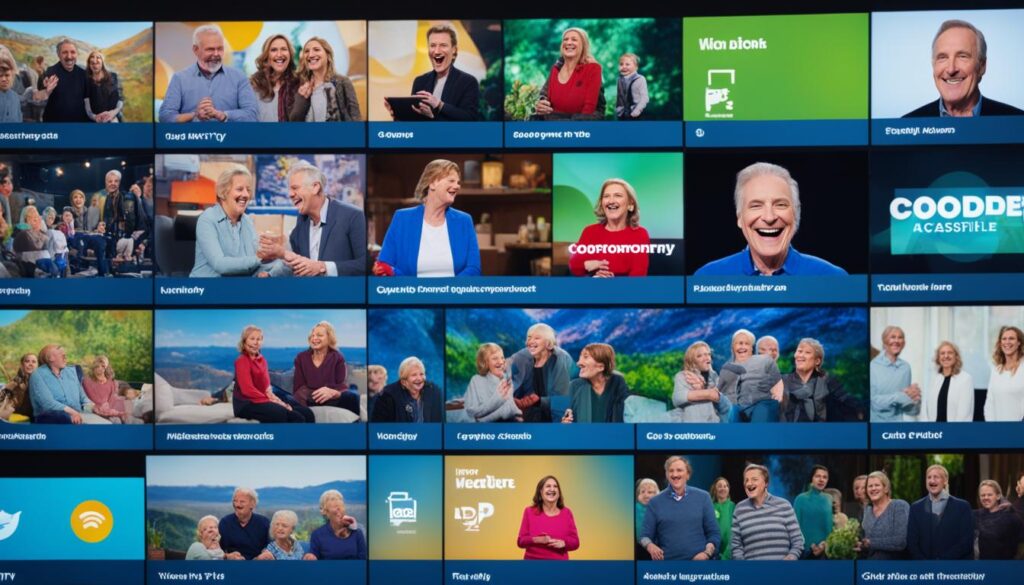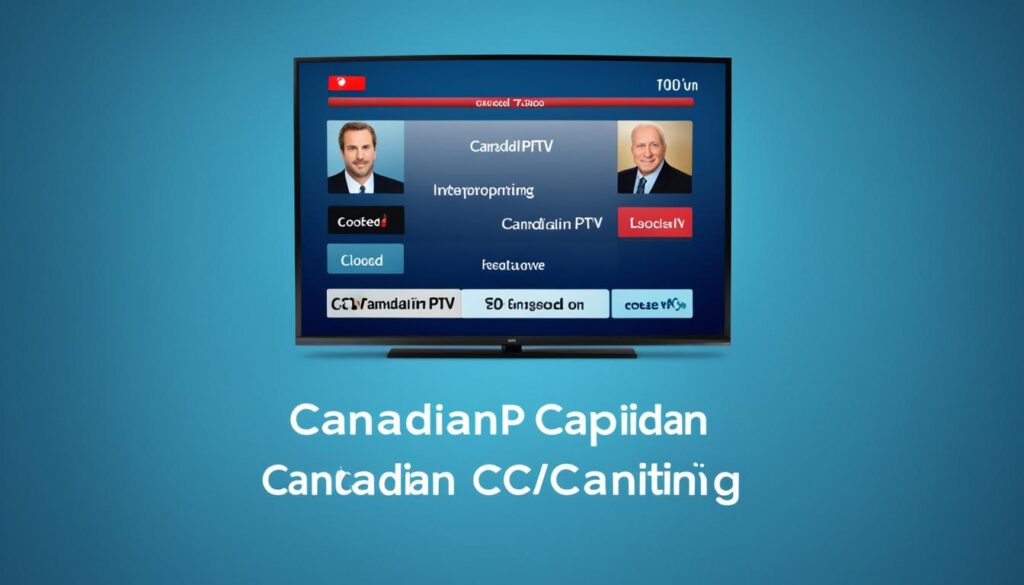In the evolving landscape of digital media, Canada IPTV services are forging a path towards more inclusive entertainment, ensuring that accessibility features are a cornerstone of the enhanced viewing experience for Canadian users. These developments have not only elevated the watching experience for those without disabilities but have been especially transformative for people with impairments. By integrating tools like closed captioning, audio description, and user-friendly interfaces, IPTV in Canada is guaranteeing that everyone has equal access to their diverse content offerings.
From streaming platforms to traditional broadcast, these accessibility features embody a commitment to diversity and representation within the entertainment medium. A remarkable step forward for Canadian IPTV services, this heightened accessibility ensures that new technologies serve the demands of all users, providing a shared and barrier-free media environment.
Key Takeaways
- Canada IPTV services are dedicated to providing accessibility features that cater to diverse user requirements.
- Inclusive entertainment is at the heart of establishing a universal viewing experience for Canadian users.
- Enhanced viewing experience comes from advancements such as closed captioning, audio descriptions, and adaptive user interfaces.
- IPTV accessibility strengthens inclusion and ensures a rich entertainment experience for individuals with disabilities.
- Accessible IPTV advances foster a culture of representation within the broader media industry in Canada.
The Importance of Accessibility in IPTV Services
In the evolving landscape of digital entertainment, the drive towards comprehensive video content accessibility remains at the forefront of innovation. Fostering inclusive IPTV services is not just a nod to technological advancement but a commitment to equality, ensuring that diverse viewing audiences in Canada have access to content that enriches their lives. Recognizing the imperative need for Canada IPTV accessibility, providers are reshaping the narrative to harmonize with the diverse requirements of their consumers.
Defining Accessibility for Video Content
Accessibility in video content refers to the deliberate integration of features that dismantle barriers for individuals with disabilities or limitations. It aligns with the principle that every person, regardless of their physical or cognitive capabilities, deserves an equal opportunity to enjoy the extensive repertoire of IPTV entertainment.
Why IPTV Accessibility Matters
The relevance of IPTV accessibility becomes pronounced when considering the breadth of its impact. An inclusive approach to service delivery becomes a testament to the provider’s commitment to equity, unveiling opportunities for all individuals to partake in the booming digital culture.
Impact on Diverse Audiences
When inclusive practices are embedded within IPTV services, the benefits ripple through our diverse society. Every step towards improved accessibility is a stride towards unity, enabling people from all walks of life to share in the joys of contemporary storytelling and connectivity.

| Accessibility Feature | Function | Beneficiary Audience |
|---|---|---|
| Closed Captioning | Visual display of audio content | Deaf or Hard of Hearing |
| Audio Descriptions | Narration of key visual elements | Blind or Visually Impaired |
| Adjustable UI Settings | Customizable text size and colors | Individuals with Cognitive or Visual Impairments |
| Voice Recognition | Hands-free navigation of content | Individuals with Dexterity or Mobility Challenges |
Enhancing IPTV with User Interface Customizations
In the rapidly evolving world of internet protocol television (IPTV), the push for user interface customizations is reshaping how viewers engage with content. Recognizing the diverse needs of their audience, IPTV platforms are actively championing personalization in IPTV, ensuring that services are not only high in quality but also genuinely accessible and user-centric.
Personalization of Accessibility Settings
Accessibility personalization represents the heart of IPTV’s adaptive transformation. Users are no longer passive consumers; they now have control over their viewing experience, tailoring their settings to match individual requirements. This leap forward in user interface customizations addresses the call for increased inclusivity, allowing everyone to navigate and interact with IPTV platforms effortlessly. The importance of this feature extends beyond convenience— it stands as a commitment to the principles of equal opportunity and full participation in the digital entertainment landscape. MaxTV acknowledges the significance of this initiative and continuously enhances its platform to support these values.
Adjustable Text and Display Options
For those seeking a more personalized IPTV experience, adjustable display settings offer a gateway to a more enjoyable and comfortable entertainment session. The ability to modify text size, color contrast, and navigate various audio options can be a game-changer for viewers with visual or cognitive disabilities. Such features embody the spirit of accessibility personalization, putting the needs of every individual at the forefront. They are not just functional modifications; they symbolize a broader movement towards a more inclusive and accommodating digital age for entertainment.
Moving ahead, IPTV platforms continue to evolve, with companies like MaxTV pushing the boundaries to integrate cutting-edge technology that fosters a more inclusive environment. The proactive approach to user interface customizations is setting a remarkable precedent, ensuring the digital evolution of television is one that brings everyone along for the ride.
Advancements in Audio Descriptive Services
With the fast-paced growth of digital media, audio descriptive services have emerged as a cornerstone of accessible IPTV features. These services represent more than just a technological leap; they indicate a powerful shift towards inclusivity in Canadian entertainment. Through meticulously crafted narratives that articulate visual cues, Canadian IPTV enhancements are allowing visually impaired audiences to fully immerse themselves in a previously inaccessible aspect of storytelling.

As part of the ongoing advancements in IPTV, providers are integrating audio descriptions into more channels and shows. This dedication not only adheres to inclusivity mandates but also enriches the viewing experience for all subscribers. Whether it’s a blockbuster film or a gripping series, the addition of audio descriptive services ensures that every scene and nuance is communicated, breaking down barriers to entertainment for those with visual impairments.
| Feature | Description | Impact |
|---|---|---|
| Integrated Audio Descriptions | Narrated descriptions of visual information during natural pauses in dialogue | Enables visually impaired viewers to visualize scenes and character expressions |
| Accessibility Options | User-friendly menus and settings to activate/deactivate audio descriptions | Gives control to users, allowing them to customize their viewing experience |
| Multi-platform Availability | Consistent provision of audio descriptive services across all compatible devices | Ensures a seamless and inclusive experience regardless of how viewers access content |
Ultimately, the drive to integrate and enhance audio descriptive services is a testament to the industry’s commitment to accessibility. Providers are not just meeting requirements; they are reaching beyond them to set new standards for how entertainment is experienced. As IPTV continues to evolve, these advancements edge us closer to a future where entertainment knows no boundaries.
Canada IPTV Services and Closed Captioning Excellence
As the standard for closed captioning excellence continues to rise, inclusive Canadian IPTV platforms are at the forefront, providing essential captioning services for deaf or hard-of-hearing viewers. Understanding the importance of complete inclusivity, these services are committed to refining and advancing IPTV captioning services to ensure every viewer has an exceptional media experience.

Achieving closed captioning excellence involves a meticulous approach to accuracy and synchronicity with on-screen content, something that Canada’s IPTV providers take seriously. Their focus is not just compliance with accessibility standards, but also on leading the industry with innovations that enhance the user experience for those who rely on captions.
Accurate closed captioning is not an afterthought but a key feature that ensures content is accessible and enjoyable for all, including deaf or hard-of-hearing individuals.
To further detail the progression of IPTV captioning services, below is a comprehensive analysis of how Canadian IPTV platforms are implementing these features:
| Feature | Description | Impact on viewer experience |
|---|---|---|
| Real-Time Captioning | Live transcription of broadcasts ensures immediate access to content as it unfolds. | Viewers experience events simultaneously with hearing audience, eliminating delays. |
| High Accuracy | State-of-the-art speech recognition and skilled captioning teams provide precise textual representation of dialogue and sounds. | Less room for misinterpretation enhances understanding and enjoyment of content. |
| Customizable Display | Options to change font size, color, and background for better visibility. | Personalized settings cater to individual user needs, facilitating a better viewing experience. |
| Multi-Language Support | Captions available in multiple languages cater to Canada’s diverse population. | Non-English speakers and multilingual individuals can enjoy content in their preferred language. |
It’s evident that the commitment to closed captioning excellence by Canadian IPTV services not only addresses the functional needs of deaf or hard-of-hearing viewers but also enriches the viewing experience. The strides in this domain exemplify the dedication of inclusive Canadian IPTV providers to create an equitable environment for all content consumers. For more information on advanced IPTV solutions, visit https://getmaxtv.com/.
Implementing Remote Control Accessibility Standards
The evolving landscape of IPTV services in Canada has put a spotlight on the importance of remote control accessibility. As consumers demand more accessible IPTV technology, service providers are looking towards universal remote designs that cater to the needs of individuals with varying abilities.
Universal Designs for Ease of Use
Recognizing the significance of intuitive use, IPTV companies are adopting universal remote designs to ensure efficient navigation for all users. These ergonomically designed remotes offer tactile buttons and voice-activated functions, making the television experience more inclusive.

The Debate Over Standardized IPTV Remotes
While universal designs are making headway, the conversation about IPTV remote standardization continues. The aim is to provide consistent user experiences across various devices and service providers. Below is a comparison of standard versus non-standard remote control features:
| Feature | Standard Remote Control | Non-Standard Remote Control |
|---|---|---|
| Button Layout | Uniform | Varies by Manufacturer |
| Voice Activation | Integrated | Limited or Absent |
| Tactile Feedback | Emphasized | May be Overlooked |
| Compatibility | Cross-Platform | Device-Specific |
| Learning Curve | Reduced | Steep for New Users |
In conclusion, the shift towards accessible IPTV technology reflects a commitment to inclusivity and ease of access for every customer. IPTV’s move to implement remote control standards could redefine the TV watching experience, making it more user-friendly for a broader audience.
Evolving Voice Control and Gesture Recognition in IPTV
For Canadian IPTV users, the future of television is now. IPTV platforms are embracing the cutting-edge developments in evolving voice control and gesture recognition technologies, transforming how viewers interact with their entertainment systems. These enhancements are not just about keeping up with technology trends; they are part of a concerted effort to ensure hands-free IPTV operation, providing an inclusive environment that caters to all individuals, particularly those with mobility impairments.
Hands-Free Operation for Enhanced Accessibility
One of the most significant strides in IPTV technology is the implementation of gesture recognition IPTV. This advancement allows viewers to navigate menus, select programs, and adjust settings with simple hand movements. Gone are the days when a remote control was the only way to interact with your TV. Today, hands-free operation increases autonomy for users with dexterity challenges, and enhances the viewing experience by creating a more user-friendly and responsive environment.
Breakthroughs in Voice Command Technologies
The rapid progress in IPTV voice command technologies is further evidence of an industry committed to accessibility and convenience. With evolving voice control, users can perform commands such as changing channels, searching for content, and controlling playback with their voice. These voice recognition systems are becoming increasingly sophisticated, understanding and interpreting a wide range of commands and accents, thus ensuring every viewer has the ability to control their IPTV service effortlessly. It’s through innovative features like these that MaxTV continues to provide an enhanced viewing experience for all Canadians, making sure that every command is just a word or gesture away.
FAQ
What are the key accessibility features in Canada IPTV services?
Key accessibility features include closed captioning for deaf or hard-of-hearing individuals, audio descriptions for the visually impaired, voice control, gesture recognition for those with mobility challenges, and customizable user interfaces. These are designed to create an inclusive entertainment environment and an enhanced viewing experience for Canadian users.
How do accessibility features in IPTV services impact video content consumption?
Accessibility features in IPTV services enable users with varying abilities to fully engage with video content, ensuring that diverse viewing audiences in Canada have equal access to entertainment. This inclusivity is crucial for the representation and participation of all individuals in the digital entertainment landscape.
Why is it important to have customizable user interfaces in IPTV services?
Customizable user interfaces allow viewers to alter accessibility settings for their individual needs, including adjustable text size, color contrast, and audio enhancements. This personalization in IPTV ensures a more accessible and comfortable viewing experience, catering to viewers with visual or cognitive disabilities.
How do audio descriptive services enhance the viewing experience for visually impaired users?
Audio descriptive services offer narrated descriptions of key visual elements during programming, which helps visually impaired users understand on-screen actions, settings, and facial expressions. This service improves the accessibility of Canadian IPTV and enables a deeper connection with the content.
What makes closed captioning a critical feature in Canada IPTV services?
Closed captioning provides text for dialogue and sound effects, enabling users who are deaf or hard of hearing to follow along with the content. Improving the quality and availability of closed captions is seen as vital to achieving captioning excellence and ensuring inclusivity in Canadian IPTV services.
How is remote control accessibility being improved in IPTV services?
IPTV services are incorporating universal design principles and standardized features in their remote controls to enhance accessibility. There is a push for standardizing IPTV remotes to minimize confusion and guarantee a consistent user experience for all customers, especially for individuals with disabilities.
In what way is voice control and gesture recognition evolving within IPTV services?
Voice control and gesture recognition technologies are advancing, providing hands-free operation and more intuitive navigation for users with mobility impairments. These breakthroughs contribute to the evolving field of IPTV and create more accessible viewing experiences for Canadian users through innovative voice command technologies.
Source Links
- https://medium.com/@mssocialmediamarketing2/ensuring-inclusive-viewing-experiences-exploring-iptv-accessibility-features-749b223cb9cb
- https://medium.com/@moore47/enhancing-accessibility-iptv-subscription-accessibility-features-for-users-with-abilities-on-black-483702bfae3d
- https://www.itu.int/dms_pub/itu-t/oth/06/42/T06420000010031PDFE.pdf



